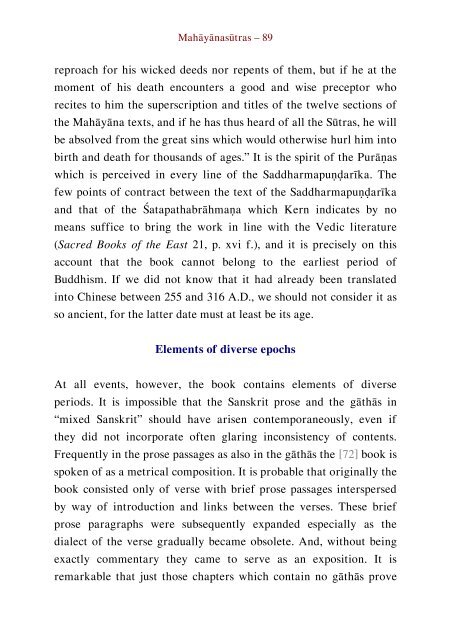Literary History of Sanskrit Buddhism
A study by J. K. Nariman of Sanskrit Buddhism from the Early Buddhist Tradition up to the Mahayana texts proper.
A study by J. K. Nariman of Sanskrit Buddhism from the Early Buddhist Tradition up to the Mahayana texts proper.
Create successful ePaper yourself
Turn your PDF publications into a flip-book with our unique Google optimized e-Paper software.
Mahāyānasūtras – 89<br />
reproach for his wicked deeds nor repents <strong>of</strong> them, but if he at the<br />
moment <strong>of</strong> his death encounters a good and wise preceptor who<br />
recites to him the superscription and titles <strong>of</strong> the twelve sections <strong>of</strong><br />
the Mahāyāna texts, and if he has thus heard <strong>of</strong> all the Sūtras, he will<br />
be absolved from the great sins which would otherwise hurl him into<br />
birth and death for thousands <strong>of</strong> ages.” It is the spirit <strong>of</strong> the Purāṇas<br />
which is perceived in every line <strong>of</strong> the Saddharmapuṇḍarīka. The<br />
few points <strong>of</strong> contract between the text <strong>of</strong> the Saddharmapuṇḍarīka<br />
and that <strong>of</strong> the Śatapathabrāhmaṇa which Kern indicates by no<br />
means suffice to bring the work in line with the Vedic literature<br />
(Sacred Books <strong>of</strong> the East 21, p. xvi f.), and it is precisely on this<br />
account that the book cannot belong to the earliest period <strong>of</strong><br />
<strong>Buddhism</strong>. If we did not know that it had already been translated<br />
into Chinese between 255 and 316 A.D., we should not consider it as<br />
so ancient, for the latter date must at least be its age.<br />
Elements <strong>of</strong> diverse epochs<br />
At all events, however, the book contains elements <strong>of</strong> diverse<br />
periods. It is impossible that the <strong>Sanskrit</strong> prose and the gāthās in<br />
“mixed <strong>Sanskrit</strong>” should have arisen contemporaneously, even if<br />
they did not incorporate <strong>of</strong>ten glaring inconsistency <strong>of</strong> contents.<br />
Frequently in the prose passages as also in the gāthās the [72] book is<br />
spoken <strong>of</strong> as a metrical composition. It is probable that originally the<br />
book consisted only <strong>of</strong> verse with brief prose passages interspersed<br />
by way <strong>of</strong> introduction and links between the verses. These brief<br />
prose paragraphs were subsequently expanded especially as the<br />
dialect <strong>of</strong> the verse gradually became obsolete. And, without being<br />
exactly commentary they came to serve as an exposition. It is<br />
remarkable that just those chapters which contain no gāthās prove


















